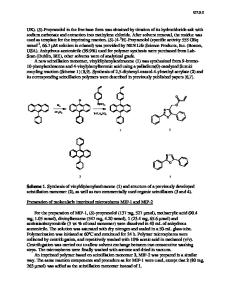Fluorometric determination of tyramine by molecularly imprinted upconversion fluorescence test strip
- PDF / 1,200,520 Bytes
- 8 Pages / 595.276 x 790.866 pts Page_size
- 66 Downloads / 308 Views
ORIGINAL PAPER
Fluorometric determination of tyramine by molecularly imprinted upconversion fluorescence test strip Yali Chen 1 & Fenfen Fan 1 & Guozhen Fang 1 & Qiliang Deng 1
&
Shuo Wang 1,2
Received: 16 April 2020 / Accepted: 7 September 2020 # Springer-Verlag GmbH Austria, part of Springer Nature 2020
Abstract A fluorometric method based on molecularly imprinted upconversion fluorescence test strip was developed for the determination of tyramine. It exploited the green fluorescence of upconversion nanoparticles (UCNPs) and the specific recognition property of molecularly imprinted polymers (MIPs). UCNPs were attached to filter paper with glue, and MIPs were prepared via in situ polymerization on the surface of UCNPs by using tyramine as template, methacrylic acid as functional monomer, and ethylene glycol dimethacrylate as cross-linker. The green fluorescence of the test strip, with excitation/emission wavelength 980/550 nm, was enhanced by tyramine. The test strip was suitable for the determination of tyramine in the linear range 1.0–100.0 mg L−1, and a relatively low limit of detection (0.2 mg L−1) was achieved. The test strip also worked well for the quantitation of tyramine in spiked red wine and mature vinegar. Recoveries are ranged from 84.9 to 99.9%. The relative standard deviations are below 5.6%. Keywords Tyramine . Molecular imprinting . Upconversion nanoparticles . Fluorescence sensor . Paper-based device
Introduction Biogenic amines such as tyramine, tryptamine, histamine, putrescine β-phenethylamine, and cadaverine are widely detected in food. Although many critical functions in human depend on this compound, consumption of food containing excessive amount of these amines can cause toxicological effects [1]. Among these biogenic amines, tyramine and histamine are receiving more and more attention due to the most significant relationship with food poisoning caused by biogenic amines [2]. Especially, tyramine shows stronger cytotoxicity than histamine. High level of tyramine in food can cause variety of adverse reactions and diseases such as migraine, cluster Electronic supplementary material The online version of this article (https://doi.org/10.1007/s00604-020-04554-7) contains supplementary material, which is available to authorized users. * Qiliang Deng [email protected] * Shuo Wang [email protected] 1
College of Chemical Engineering and Materials Science, Tianjin University of Science and Technology, Tianjin 300457, China
2
Tianjin Key Laboratory of Food Science and Health, School of Medicine, Nankai University, Tianjin 300071, China
headaches, brain hemorrhage, lachrymation, high blood pressure, diarrhea, salivation, and nausea [3]. In addition, the level of tyramine in red wines is evidently related to the wine quality and reflects important information about the quality of storage and manufacture’s environmental hygiene conditions [4–6]. Hence, a suitable method for rapid and real-time detection of tyramine has a significant effect on food safety and human health. Currently, th
Data Loading...











